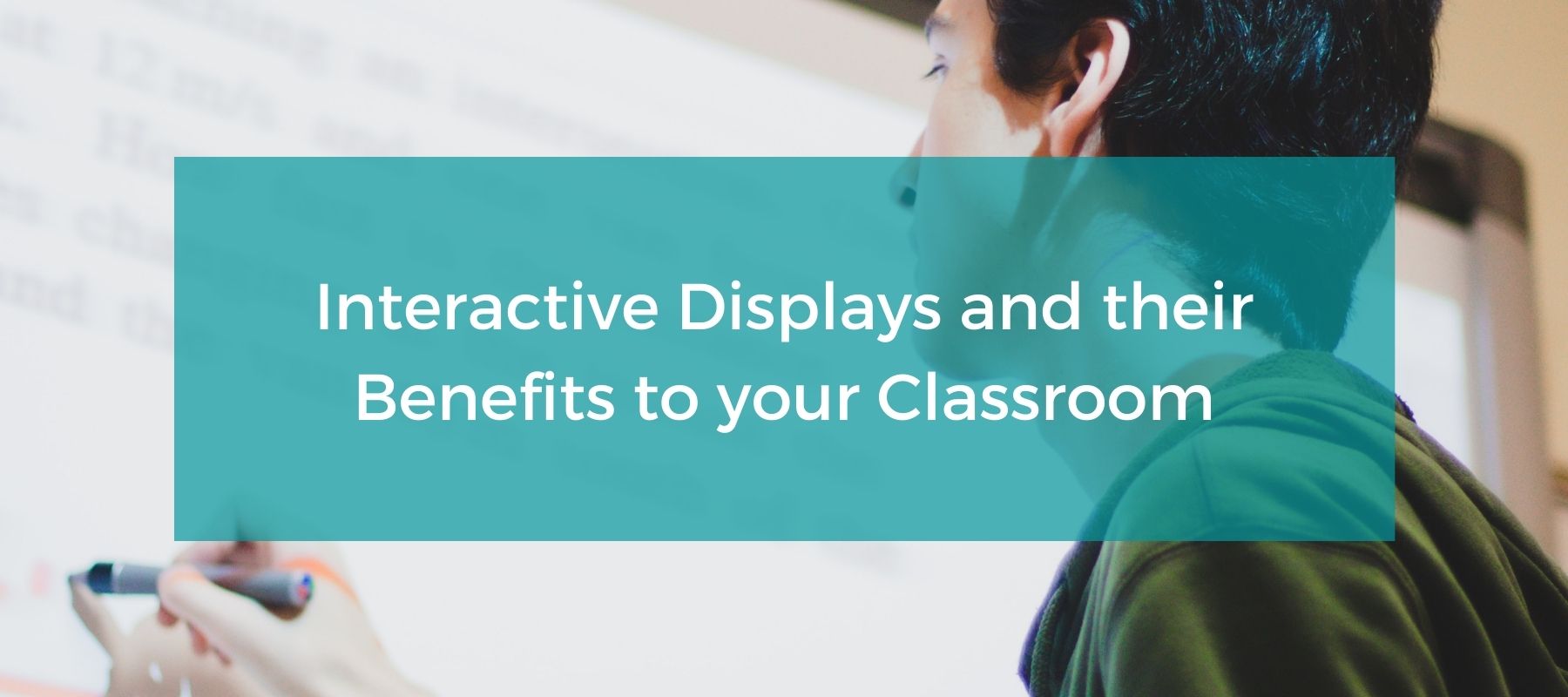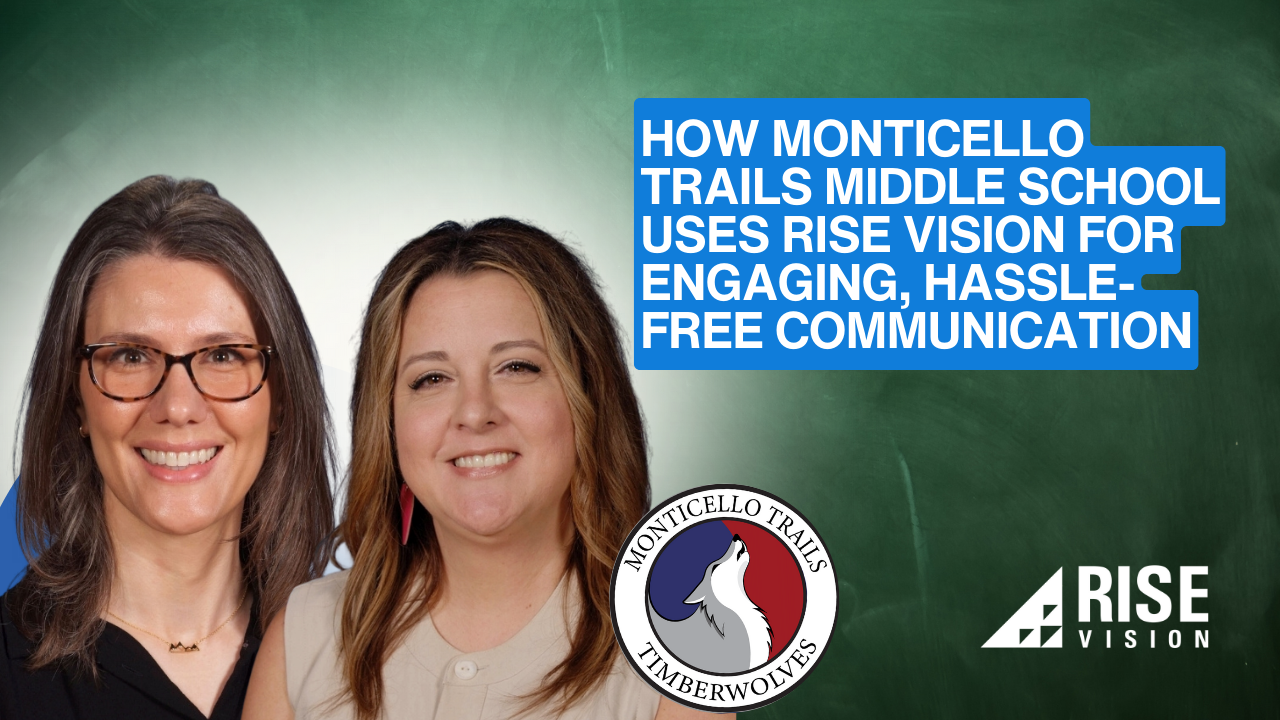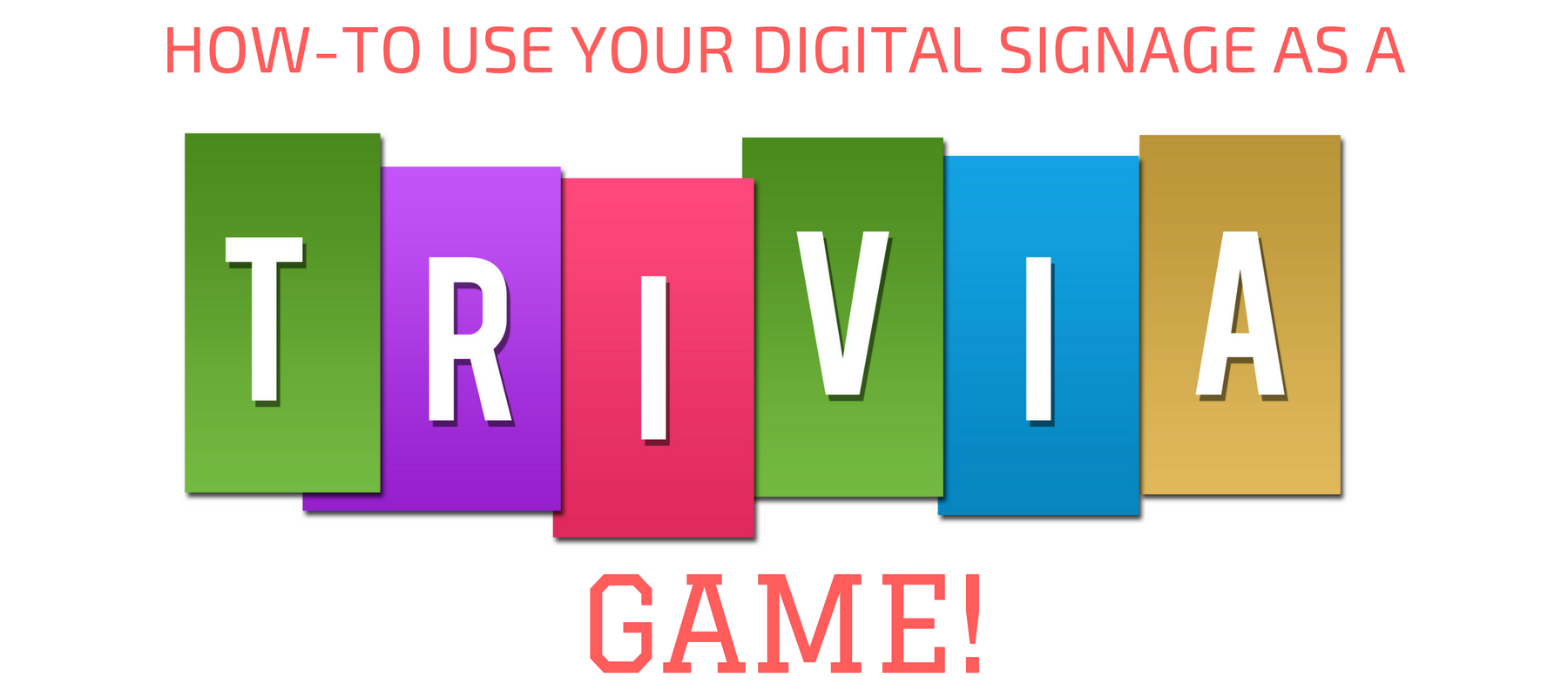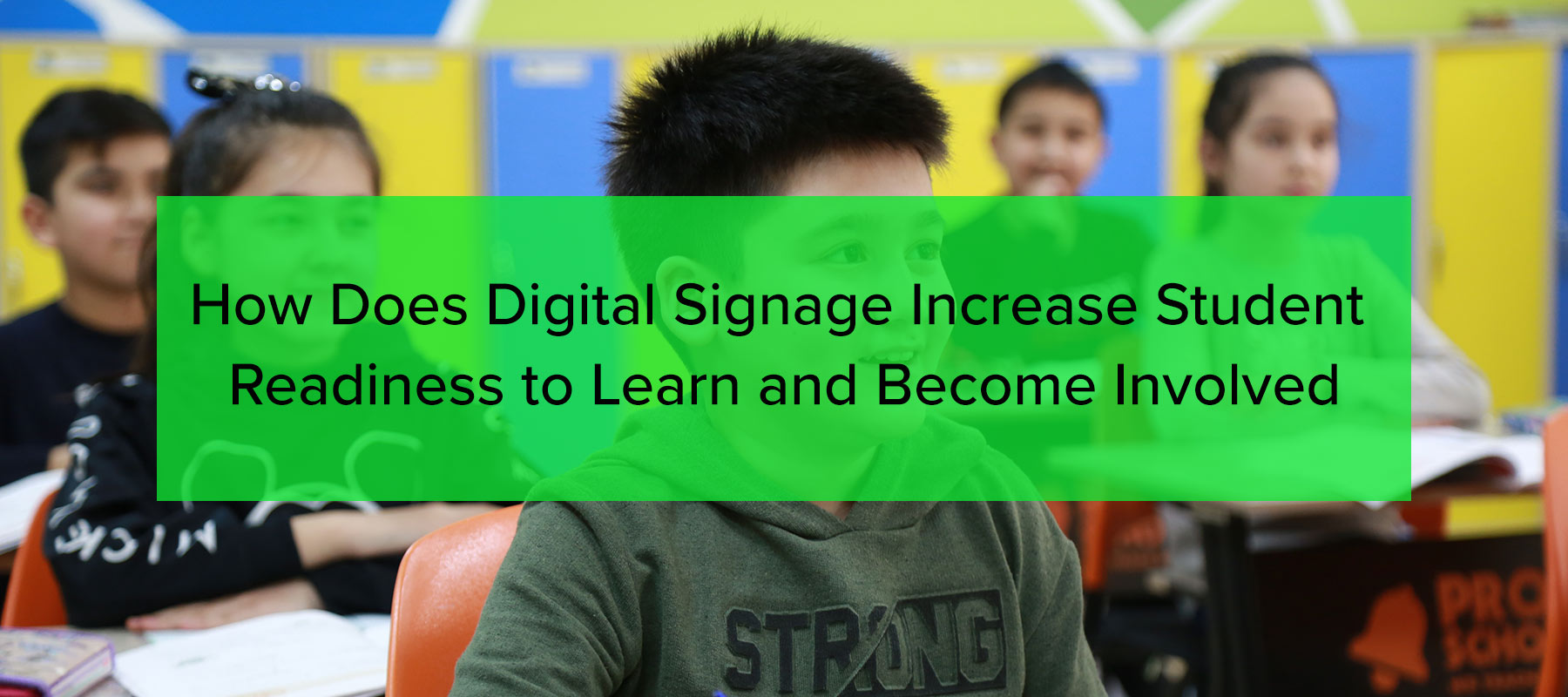
Digital signage can do more than keep students up to date with scheduling. It can be an effective tool to help students develop confidence, interpersonal skills, and improved academic performance. As schools strive to improve student engagement and get the best academic and life outcomes for every student, digital signage can be a crucial, transformative element.
Let’s start with where students are.
Students Are Digital Natives
It’s worth remarking: anyone who’s a student in a K-12 school now cannot remember a time before the internet. These are all people born after 2004; the iPhone came out when the oldest of them was four years old. What’s ‘new technology’ to us is just the way things are to them. They expect the kind of availability and responsiveness they’ve been trained to by mobile operating systems and apps. That’s how user-friendly we should strive to be too.
This brings up the question: is moving digital technology into the classroom a way to pander to students, or to cater to them? Is it superficial, or can we point to real evidence that it improves outcomes? In fact, we do have that evidence.
Digital Signage Drives Engagement
Digital signage radically increases engagement. There’s a phenomenon called ‘inattentional blindness,’ which consists of ‘looking without seeing.’ It occurs when we’re doing something ‘procedurally,’ meaning following steps without thinking about them. Ever drive home and arrive with no recollection of how you got there? That’s inattentional blindness. Same roads, same turns… same signs.
It’s the same for students walking the halls of a school. They might pass a static sign five times a day, five days a week, for months or years. Unless something happens to draw their attention to it, they won’t see it.
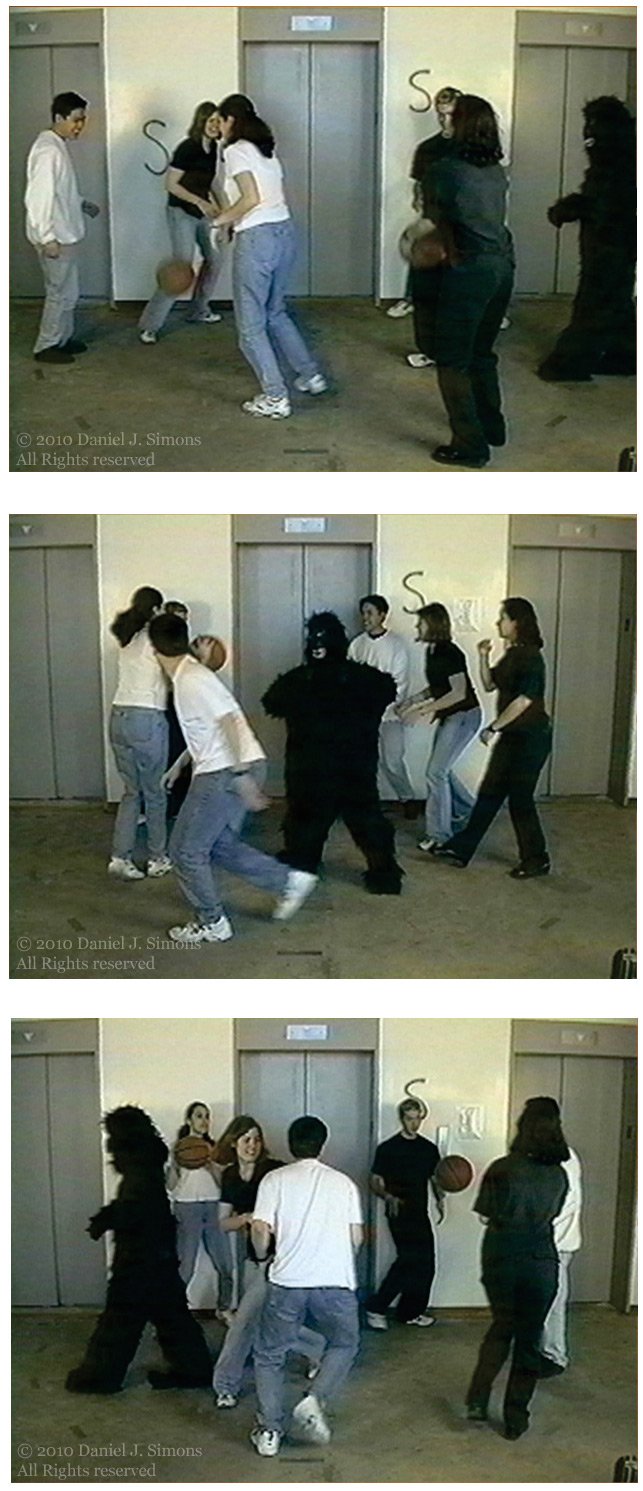
This series of images is provided by Daniel Simons, and taken from the 1999 study by Simons, D. J., & Chabris, C. F., entitled ‘Gorillas in our midst: Sustained inattentional blindness for dynamic events,’ first appearing in Perception volume 28, 1059-1074.
In this study, viewers were asked to count how many players in white shirts passed the ball. Fully 50% of viewers didn’t see the person wearing a gorilla suit walking through the scene. That’s how powerful inattentional blindness is.
We have to manage inattentional blindness carefully because it has a sibling effect, ‘change blindness.’ Change blindness means not seeing major changes in a familiar setting. Sounds like we can’t win, but psychologists have identified how to get people’s attention without running into either deficit. It requires changing messages and images, located in predictable places.
That’s what digital signage does, and the stats bear out its efficacy. Digital signage can attract up to 400% more views than static signage. In a class of 30, that’s the difference between six people seeing it, and everyone seeing it.
There’s anecdotal evidence too. We hear from a lot of our users that ‘paper handouts and static signs — people just pass straight through them and they don’t read them. Everyone is drawn to screens,’ as Jason Murray or Cornwall-Lebanon School District puts it.
Classroom Tips
- Regularly change what’s shown on in-class digital signage so students don’t develop inattentional blindness towards our displays.
- Show messaging that’s appropriate to the task, class or time of year so students have a reason to pay attention.
- Use digital signage as an active teaching tool when it makes sense; when it doesn’t, display generally useful information and students will still see it because they’ve learned to regard the digital display as a useful source of information that regularly changes.
Digital Signage Drives Retention and Attention
Students aren’t just looking at signs more. They’re remembering them, thinking about them, and talking about them. In studies on consumers, brands found that digital signage resulted in between 13% and 41% more retention. These effects can be magnified by placing signage strategically, near places students congregate to wait such as entrance halls and water fountains.
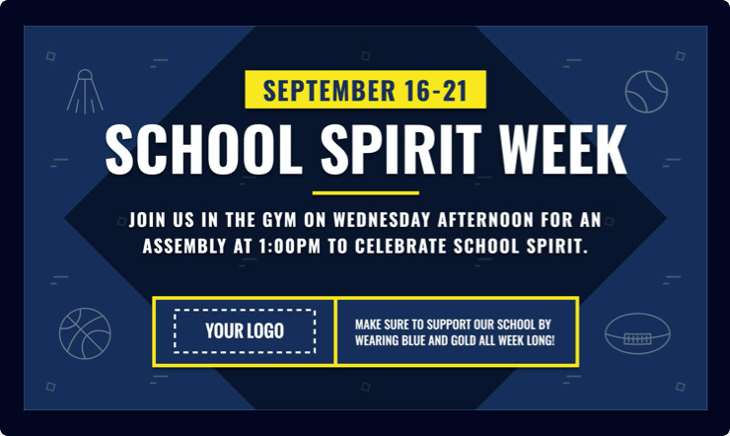
Rise Vision's School Spirit Digital Signage Template
It’s particularly useful to locate whole-school announcements in major public areas of the school.
It’s also effective to locate signage in places where messaging is relevant to tasks students are trying to complete, such as libraries, gyms, or classrooms. 
Rise Vision's School Library Digital Signage Template
(Rise Vision’s Unlimited license lets schools easily schedule and display content schoolwide, for a flat, simple and transparent fee.)
But these aren’t the only uses for digital signage in schools. There are specific ways the power of digital signage can be leveraged to improve students’ readiness to learn, encourage them to become involved, and help build confidence and a sense of ownership.
Classroom Tips
- Encourage active recall by referring to the information displayed on digital signage so students practice checking, absorbing, and recalling it.
- For ideas on what to display, consider which questions students ask most frequently, or which information they tend to forget. Displaying material like this all encourages engagement with the displays and helps us use them as a direct and indirect teaching tool.
- Consider leveraging the specific uses of digital signage described below.
Priming With Digital Signage
‘Priming’ means being put into a certain frame of mind by a stimulus, and then reacting differently to subsequent, related stimuli. For example, people will recognize the word ‘nurse’ faster after having been shown the word ‘doctor,’ because seeing ‘doctor’ makes us think ‘medicine-hospital-surgery-nurse’ — we’re ‘primed’ to see things that fit into the pattern.
The effect can be both powerful and profound. In ordinary life, it’s the source of ‘mondegreens’ — misheard lyrics to songs, where we fill in ambiguous lyrics with words of our own. In education, it’s associated with some surprising outcomes.
Praising students’ intelligence can reduce overall educational attainment, per Mueller and Dueck’s famous 1998 study, by priming them to think of success as a natural consequence of inbuilt, unchangeable ability: a ‘fixed mindset.’ In this mindset, if you perform well in a task, it means you’re smart. If you don’t, it means you’re not.
But students can be primed another way: ‘we can learn to do it.’ Priming for a growth mindset, in which failure means you need to learn how to do it and then try again rather than accept your inability, is associated with significant improvements in ‘post-failure’ outcomes. After students fail a task, those primed for a growth mindset feel they can learn to do it better the next time around. They’re learning self-efficacy instead of predetermination. These are key skills for life and study, and we can use priming to help students experience, value, and internalize them.
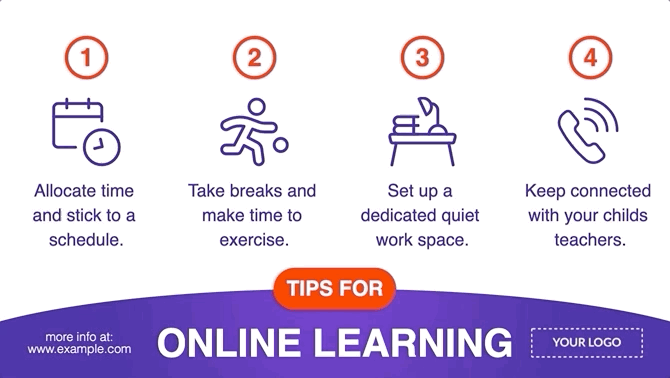
Rise Vision's Online Learning Tips Digital Signage Template
Priming works, and digital signage can be used to prime students to view themselves as competent and motivated learners who can handle the material. We can also use priming to help students navigate difficult circumstances and ambivalent inputs better. ‘When exposed to positive personality traits (e.g., “adventurous”, “independent”) or negative traits (e.g., “reckless”, “conceited”) before reading an ambiguous paragraph about a theoretical person,’ explain Cherice Chan and Dillon Murphy in Psychology In Action, ‘participants rated and characterized the theoretical person as more positive or more negative, respectively.’
In other words, priming can affect everything from how we see ourselves to how we experience events, altering the outcome of difficult personal interactions — or difficult math questions.
Digital signage can be used to display priming messaging in hallways and classrooms, improving student self-perception, self-efficacy, and readiness to engage with lessons.
Classroom Tips
- Use digital signage to prime students for success and for improved post-failure outcomes by encouraging a growth mindset.
- Help students identify with positive and resilient character traits by showcasing those behaviors using digital signage. Use characters students can identify with, or better yet, showcase students themselves.
Nudging and Digital Signage
Nudging exists in the space between making something compulsory and forbidding it. It’s the idea of using a structure of incentives and disincentives to encourage desirable behavior. You can see it in the prices of cigarettes: reducing smoking is a public health goal, and cigarette pricing has risen to make smoking more difficult and expensive. Together with bans on smoking indoors and increased support to quit, the effects have been significant: under the influence of these efforts, smoking has declined by 7% to just 13% of American adults, in just 17 years.
In schools, this type of behavioral ‘nudge’ can be effective even without direct rewards; just reminding students of the type of behavior that’s desirable is enough to see results. When a static sign was mounted near handwashing facilities in a medical center, the (worryingly low) compliance of doctors wasn’t affected. When a digital sign was mounted in a similar facility, compliance went from 7.6% to 49%, a 650% increase.
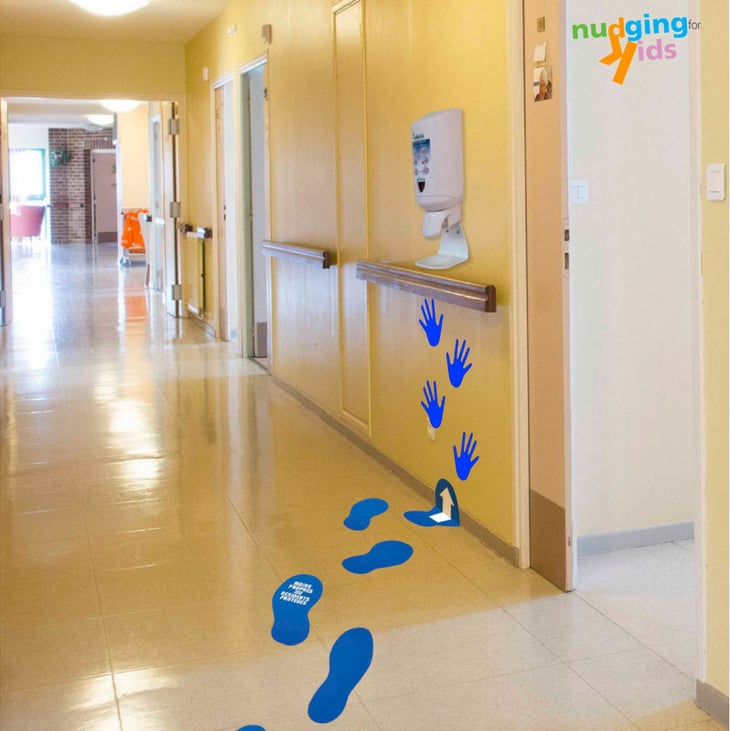
Similar effects can be seen in schools, helping to nudge students toward engaging in lessons.
These nudging efforts can be effective when they focus on behaviors that lead to engagement: modeling, encouraging, or validating actions like reading aloud in class is more effective than simply instructing students to do it, which can feel hectoring.
Classroom Tips
- Nudge gently, appropriately, and supportively. Encourage good behavior rather than discouraging bad.
- Combine nudging with priming for best results, teaching students to see themselves as capable and act like it.
- Nudge for small, intermediate goals: remembering formulae because it makes everything else easier, or asking why a character acted a certain way, helps students construct their own success.
Digital Signage, SEL, and Behavioral Goals
Student engagement has a strong social and emotional component. While teachers are (all too) aware of a noisy minority who actively refuse to become involved with lessons, up to 20% of students may be quietly disengaged. They’re not disruptive and don’t present with ‘behavioral problems’ — but they don’t learn either.
Many of the goals that educators and parents see as academic outcomes are actually experienced by students as social and emotional processes. That explains why one of the most effective academic interventions a school can undertake is strategic SEL. Without being directed toward academics directly, SEL programs can yield significant changes. Around a quarter typically show improved attitudes and conduct; slightly more (27%) show improved overall academic performance, while 57% gain skills.
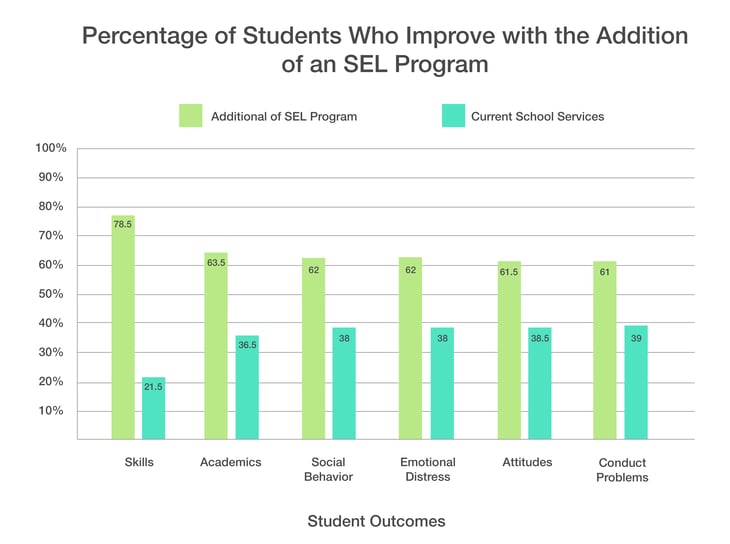
Pursuing SEL goals in combination with the other goals outlined in this guide can yield impressive results for schools, and for students too. Many students who don’t engage with lessons are socially disengaged with peers too. They’re exhibiting a cluster of behaviors that stop them from learning, stop them from relating to their peers, and hold them back in every area of life. And these behaviors are principally emotional in origin; we should meet them where they are, rather than seek academic solutions for personal problems.
(You can download Rise Vision’s SEL templates for free here.)
Cultural and Personal Affirmation
Many students, particularly from minority groups, can feel as if their cultural identity is at odds with scholastic achievement — that ‘school is not for people like them.’ This can quietly do a lot of harm, especially if the message isn’t rebutted by the school.
One of our users, Chief Leschi School, uses their digital signage to display their school Twitter feed. They’re a tribal school, but they’re careful to show the identities of all their students and staff in a positive light, and the school reports good results. Just as with SEL, this isn’t just about making students ‘feel better’ in a vacuum; it’s about linking their view of themselves with positive qualities like self-efficacy and competence.
These identities need not be ethnic to matter: LGBTQ youth thrive when schools and families are accepting and affirming of their identities, and schools can play a major role in improving the life outcomes of such individuals simply by telling them and their peers that school is a place they belong.
Skills Development and Digital Signage
One reason many kids don’t speak up in class is because they know they don’t have the requisite skills. They don’t want to read their paper aloud because they know it isn’t very good. When you know that engagement will be humiliating or unrewarding, why would you want to get involved? Better to become one of the 20% of school students who quietly, unobtrusively fail.
Obviously, these students need emotional support and an accepting space to learn and grow. But they also need skills development. Without it, they won’t overcome the practical hurdle that their work isn't adequate.
Skills development isn’t linear. Interventions at crucial stages can accelerate the process. These are more effective when they’re combined with guidance to improve basic research skills, reminders of the essential tools for the task in hand (such as formulae in science class), and even potted tutorials. Digital signage can display all these to the right students at the right time.
Digital Signage Can Be Used to Reinforce Recall
It can also be used to reinforce and encourage skill development. When students follow a train of thought, it’s often derailed the first time they don’t know what to do next. It jumps the rails, and they do something immediately rewarding instead of pursuing the long-term goal they were working on.
Most teachers have seen this happen. Most of us recognize it because it happens to adults too. In libraries and study areas, digital signage can help prompt students with the information they need to continue researching or learning. It can remind them of key concepts relevant to their area of study and appropriate to their level. That can be times tables, equations, or the concept of a ‘microcosm’ in literature. Digital signage can also help students learn how to conduct their own research in the school library.
Building Confidence, Taking Ownership
One of the most effective ways to teach someone is to have them teach you something. There’s nothing like explaining something to make you realize the gaps in your own knowledge. And students love the chance to get into the driver’s seat. Digital signage can let students do this in various ways.
A lot of our users tell us about the successes they’ve had getting their students to create content for their schools. That can be news, features, informative content, and more; some schools have entire morning news shows, filmed in studios at the school, created entirely by students.
In the process, students learn hard skills related to media production, but also soft skills: how to disagree with a colleague without rancor, how to edit their own work, or how to plan a project and stick to deadlines. Those skills are crucial in the rest of their school day — and in their careers once they leave.
Conclusion
Digital signage can be a toolkit to communicate more effectively with students, allowing schools to encourage, uplift, and guide in hallways, classrooms, and libraries. It can be used to improve basic skills and target specific ones. Schools can showcase diverse success, focus on a particular group — such as for Black History Month — or emphasize tolerance and respect. Most importantly, digital signage can offer schools a versatile way to support greater engagement and integration, helping students get the best from their classes and the social life of the school.


